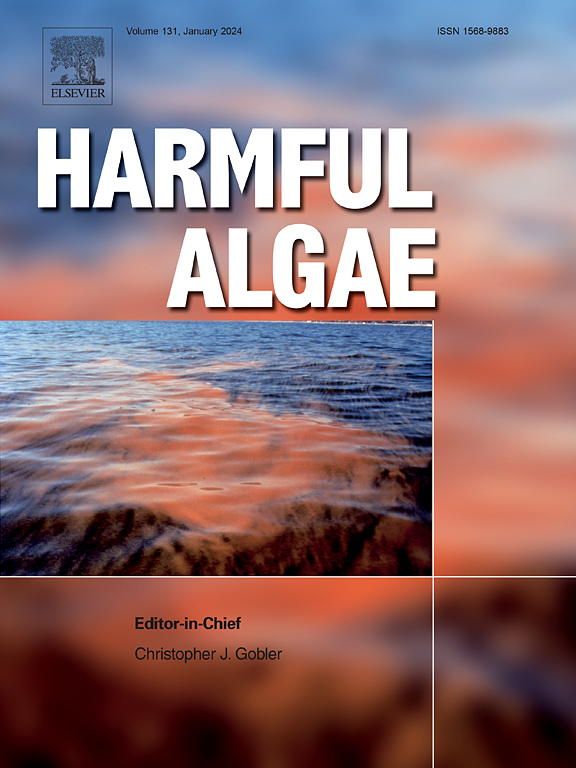Transcriptomic comparison unveils saxitoxin biosynthesis genes in the marine dinoflagellate Gymnodinium catenatum
IF 4.5
1区 生物学
Q1 MARINE & FRESHWATER BIOLOGY
引用次数: 0
Abstract
The marine dinoflagellate Gymnodinium catenatum is known to produce saxitoxins (STXs) that are responsible for paralytic shellfish poisoning (PSP); however, the genes involved in STX synthesis are insufficiently understood. In the present study, we determined transcriptome sequences of toxic G. catenatum isolated from Korea (Gc-KR) and compared them with G. catenatum strains reported in other regions such as Spain (Gc-SP) and the United States (Gc-US). Toxin analysis showed that the Korean strain produced the toxins at 6.0 ± 1.9 STXs eq fmol/cell. Comparative transcriptomics of the three strains identified more than 1000 homologs of nearly all STXs biosynthesis genes in dinoflagellates, except sxtB, sxtN, and sxtY. Gene expression analysis revealed similar sxt expression patterns across all strains, with the highest expression levels observed for sxtA and sxtG. Phylogenetic analysis of sxtA, sxtG, sxtI, sxtU, and sxtS revealed distinct evolutionary patterns, with sxtA being more conserved across G. catenatum, Alexandrium spp., and toxic cyanobacteria, particularly at the sxtA4 domain, suggesting its significance in STXs synthesis. Other sxt genes in G. catenatum showed distinct patterns and significant divergence from Alexandrium spp., suggesting independent acquisition in G. catenatum. Moreover, the absence of core genes, such as sxtB, indicates it may not be essential for STXs production in G. catenatum. These findings provide insight into the sxt candidate genes in G. catenatum, enhancing our understanding of STXs biosynthesis in dinoflagellates.
转录组学比较揭示了海洋甲藻裸子藻的蛤蚌毒素生物合成基因
众所周知,海洋甲藻裸子鞭毛虫会产生导致麻痹性贝类中毒(PSP)的蛤毒素(STXs);然而,参与STX合成的基因还没有被充分了解。在本研究中,我们测定了从韩国分离的毒钩状螺旋体(Gc-KR)的转录组序列,并将其与西班牙(Gc-SP)和美国(Gc-US)等其他地区报道的钩状螺旋体菌株进行了比较。毒素分析结果表明,韩国菌株产生的毒素为6.0±1.9 STXs eq fmol/细胞。三株菌株的转录组学比较发现,除sxtB、sxtN和sxtY外,鞭毛藻中几乎所有STXs生物合成基因都有1000多个同源基因。基因表达分析显示,所有菌株的sxt表达模式相似,其中sxtA和sxtG的表达量最高。sxtA、sxtG、sxtI、sxtU和sxtS的系统发育分析显示出不同的进化模式,其中sxtA在G. catenatum、Alexandrium spp.和有毒蓝藻中更为保守,特别是在sxtA4结构域,提示其在STXs合成中具有重要意义。其他sst基因表现出不同的模式,并与亚历山大属存在显著的差异,表明其是独立获得的。此外,缺少核心基因,如sxtB,表明它可能不是G. catenatum产生STXs所必需的。这些发现提供了对G. catenatum中STXs候选基因的深入了解,增强了我们对鞭毛藻中STXs生物合成的理解。
本文章由计算机程序翻译,如有差异,请以英文原文为准。
求助全文
约1分钟内获得全文
求助全文
来源期刊

Harmful Algae
生物-海洋与淡水生物学
CiteScore
12.50
自引率
15.20%
发文量
122
审稿时长
7.5 months
期刊介绍:
This journal provides a forum to promote knowledge of harmful microalgae and macroalgae, including cyanobacteria, as well as monitoring, management and control of these organisms.
 求助内容:
求助内容: 应助结果提醒方式:
应助结果提醒方式:


